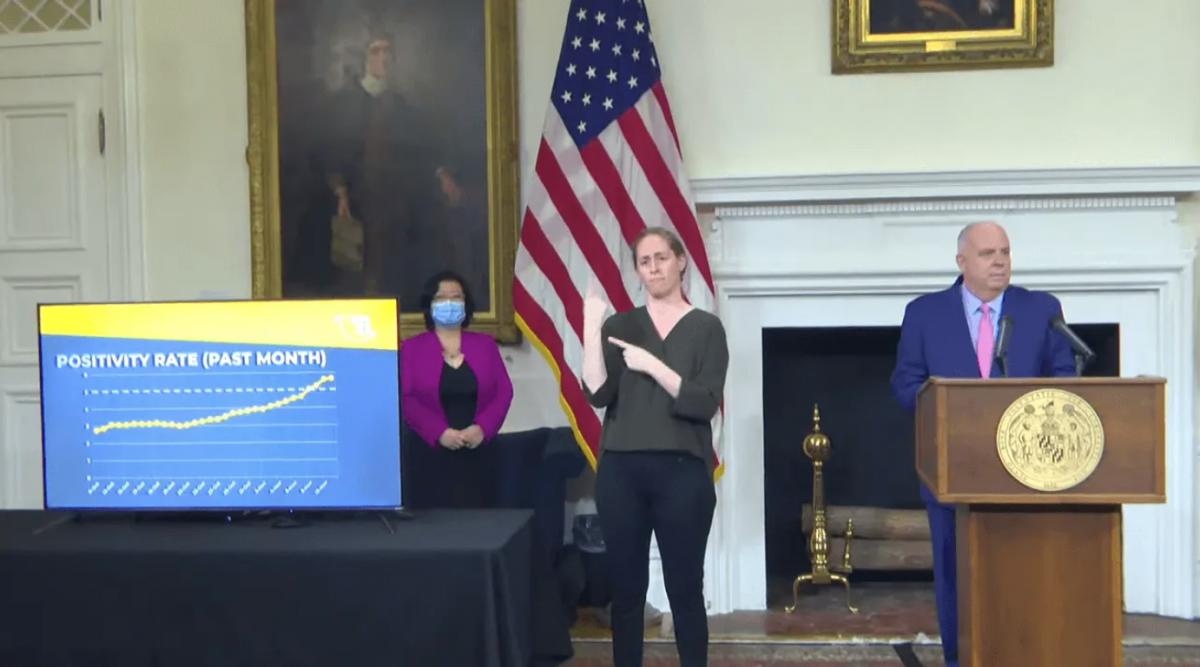As the coronavirus continues to surge across the nation, Gov. Lawrence J. Hogan Jr. (R) dispensed more federal money to boost the state’s emergency response to the virus.
“The sad truth is that the next several months will likely be by far, the most difficult that we have faced,” Hogan said in a State House news conference late Thursday afternoon. “Unfortunately we have more tough times ahead of us, and it’s going to get worse before it gets better.”
On Thursday, the state reported a positivity rate of 5.65%, the highest it’s been since May 27, as well as an additional 1,477 cases over past 24 hours. For nine days in a row, the state has reported over 1,000 new daily cases.
Maryland is currently in the “red zone” for COVID-19 cases as designated by the federal government, along with many other states, Hogan said. The average number of cases per 100,000 residents has risen to 22.8, which is a 52% increase in just the last seven days.
On Sunday, Maryland’s coronavirus positivity rate passed the 5% benchmark, a metric set by the Centers for Disease Control and World Health Organization to track the spread of COVID-19, for the first time since June 25, and has only increased since then.
Half of Maryland’s jurisdictions have positivity rates higher than this benchmark: Allegany, Anne Arundel, Baltimore City, Baltimore County, Charles, Frederick, Garrett, Harford, Prince George’s, Queen Anne’s, Somerset and Washington.
In response to the recent spike in cases, Hogan announced an additional $70 million in state spending through the federal CARES Act:
- $20 million for a strategic stockpile of personal protective equipment; Maryland currently has a 90-day supply, Hogan said.
- $15 million for more staffing support in call centers, customer service and fraud detection programming in the Maryland Department of Labor
- $10 million for rental assistance for low-income tenants
- $10 million for vaccination planning and equipment, such as syringes
- $10 million for food banks
- $2 million for the Maryland Department of Human Services for foster care assistance
- $2 million to the Maryland Department of Human Services for food (Supplemental Nutrition Assistance Program) and energy assistance
- $1 million to sample wastewater to test for coronavirus outbreaks in vulnerable communities
Hogan urged the counties to spend their remaining CARES Act funding as soon as possible, emphasizing that the money would be forfeited if not spent by the end of the year. “We have a desperate need right now,” Hogan said.
Hospitalizations due to the coronavirus increased by 53% in the last two weeks, with 863 patients currently hospitalized in Maryland, which is the highest level since June 11. Meanwhile, 199 patients are in intensive care units in Maryland.
The number of COVID-19 related hospitalizations in the nation surged to its highest to over 65,000 patients on Wednesday.
“We are experiencing an out of control spike across the United States and we are seeing widespread community transmission here in Maryland,” Hogan said.
Even so, Dr. Jinlene Chan, deputy secretary of public health services for the Department of Health, and Hogan said the state’s health metrics for reopening schools have not changed.
“It [school reopening decisions] ultimately is the decision of the local school board in conjunction with the local health department,” Chan said. She encouraged school districts to balance the needs of education and mental health for children.
As funding from the Paycheck Protection Program and CARES Act trickles out, Hogan blamed Congress for its inability to reach a compromise on the next COVID-19 stimulus package.
“We’re very, very concerned with the continued gridlock, divisiveness and dysfunction in Washington, while people’s lives are at stake and people’s economic lives and their mental health,” Hogan said.
As “people in the White House are focused on fighting elections and the people in the Biden administration don’t have any information…there’s a little bit of a vacuum right now,” Hogan said.
In the spring, the state had to rent an ice rink as funeral homes and morgues became overloaded with people who had died from COVID-19, Hogan recalled. “We do not want to be in that situation again,” he said.
On Tuesday, Hogan reduced dine-in capacity for bars and restaurants from 75% to 50%, advised against traveling to states with a positivity rate above 10% and encouraged telework.
He said his goal is to keep as much of the economy open as possible, but so is preventing the hospitals from overflowing. “Might we have to take more restrictive action over the coming weeks or months? Absolutely, we might,” Hogan said.
By Elizabeth Shwe

